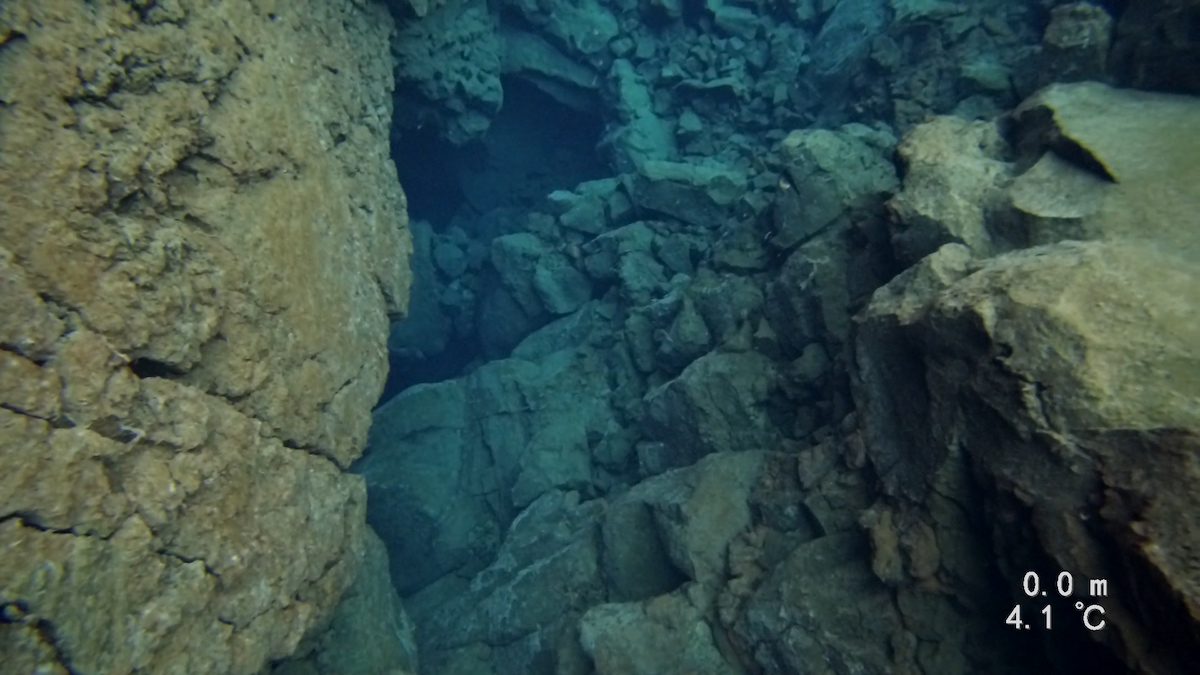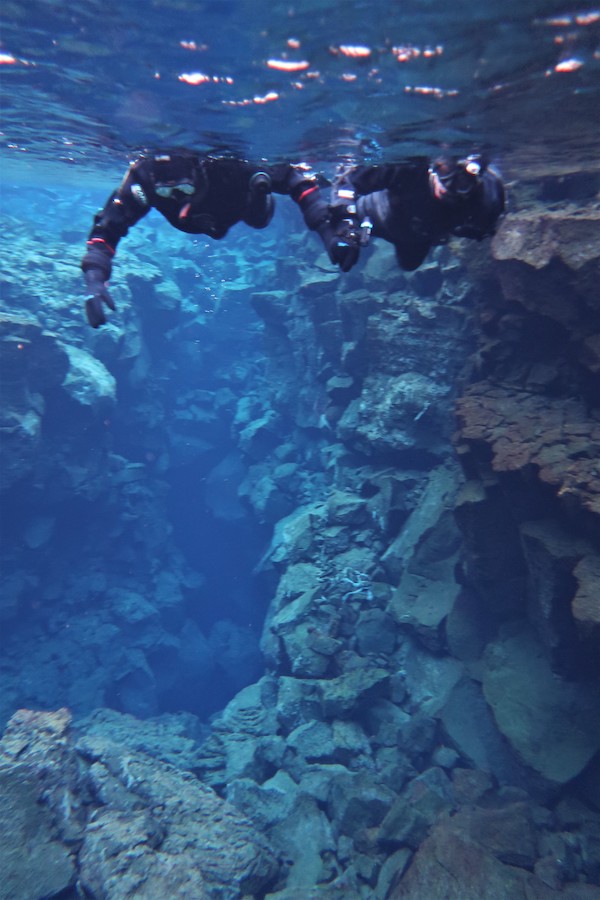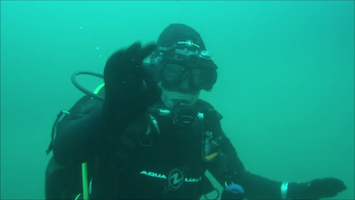By: Frank Morrow
Iceland is called the land of fire and ice. I would add that it’s the land of the purest, clearest water on earth. The people of Iceland can rightly boast that their water is the purest on the planet.
Any adventure-loving person can experience just how pure and clean it is at the Silfra Fissure.
The Silfra Fissure is where the North American Tectonic plate and the European Tectonic plate are moving apart, at about 1—2 inches (25.4mm – 50.8mm) a year. Groundwater springs out of the rock and flows through the fissure to Thingvallavatn Lake. Some people say that it takes 40 years to filter through the volcanic rock to get to the lake, and that is why it is so pure.

Snorkeling the Silfra Fissure
You can experience this wonder of nature in two ways. If you are a certified scuba diver with an additional certification in drysuit diving, with experience in diving with a drysuit, then you can scuba dive the Silfra Fissure. Everyone else can snorkel the fissure.
We opted to snorkel for two reasons. The first is that my wife Lynn wished to participate and she is not drysuit certified. The second reason is that our good friend Jean was concerned about carrying the scuba gear on the .21-mile trek back to the staging area with her bad knee. The walk back of .21 miles would have pushed me to my limit. I was happy to go with Lynn and Jean.

I chose to go with Dive.IS dive shop and we were all pleased with the equipment, the instructors and the divemasters. The attention to detail was impressive.
Snorkelers need to be comfortable in the water, but do not need any experience in snorkeling; just follow the directions of the instructors and divemasters. Each dive leader on this trip had a maximum of 6 divers to lead. I noticed that each dive leader was carrying rescue and safety equipment on their person for emergencies. Our dive leader was Dave.
To protect ourselves from the 35-degree Fahrenheit temperatures (about 2 degrees Celsius) we wore our own base layer of thermal underwear and two pairs of wool socks. They provided another thermal undergarment to put over our base layer, which we put on in a large van—we also had a place to sit where it was warm, and a dry place to store our clothes. Then we had a drysuit over top, which they zipped us into; the neck seal and wrist seals were carefully adjusted so no water could leak in.
At this point, there was a short and to-the-point briefing on the dive. The air temperature was in the low 40 degrees Fahrenheit with wind, rain and sleet, but we were warm and comfortable. The Dive.IS team assisted us with putting on our hoods and 3-finger mittens. Dave handed out masks, snorkels and fins. Then we walked across the road and over to the entry point and waited our turn to get into the water. Dive.IS had scuba diving groups as well as other snorkeling groups, and there were other dive shops there with their groups. As far as I could tell, every dive leader had professionalism, intensity and thoroughness born from taking care of people on their diving trips.
Before we put our masks on, they were sprayed with an anti-fog medium. After our masks were on, the snorkels were checked and adjusted. Fins were next, and again Dave was there to help everyone to be sure their fins were checked and adjusted. The stairs were wide and with plenty of handrails to allow you to descend with your fins on. Once you are about chest-deep in the water, you can look down into the bluest and clearest water you have ever seen. The bottom is 10 meters, or 33 feet, below you.

As the tectonic plates move apart, they break the rock into blocks with sharp edges and corners. The volcanic rocks are dark gray. As the light goes deeper, the water filters out the colors, with blue being the last color to be filtered. Since there is no turbidity, dirt, algae or sand to reflect any of the other colors here, all you see is blue. As you move away from the entry point, the depth of the Silfra Fissure drops to 99 to 140 feet deep but every rock, every edge and every corner is clearly seen.
After 30 minutes you reach the exit point. Jean, Lynn and I were still warm and dry in our suits. There were safety divers on the exit stairs to help us take off our fins and masks. We walked back to the parking lot to take off the drysuits and enjoy a cup of hot chocolate and chocolate cookies before we headed back to our hotel.
I encourage everyone to dive the Silfra Fissure—either scuba or snorkeling.

Tips for success on your Silfra Fissure adventure
- For the best experience do what the dive shops and dive leaders tell you to do; they have done this hundreds of times. Go to be impressed by their ability and the beauty of the fissure and not to impress.
- If you are 60 years old or older, like us, you will need a doctor’s okay on a medical form.
- Wear a base layer to the site. Don’t say you can take the cold; you want to be comfortable. It is easier to stay warm than to try to warm up in 35-degree Fahrenheit water.
- Take a towel; you will need to dry your hair and hands.
- Take an extra pair of thermal underwear, just in case the suit leaks.
- There are restrooms at the parking lot for the divers but you change in the vans.
- Take your camera but purchase their photos of your dive. I am very pleased by the action shots that Dave took of me and Lynn together. Jean is very happy with the photo that looks like she is pushing the tectonic plates apart.
Interested in other snorkeling adventures? Have a look at our guide to snorkeling the Dry Tortugas off of Key West, Florida!
About the Author
 Frank Morrow has been a SCUBA diver since 1970, a PADI Dive Master since 1974, a PADI Instructor since 1979, and a PADI Master Instructor since 1994—he has been actively teaching scuba diving for 49 years. He enjoys exploring the fresh waters of the Northeast US, and the salt waters of the Mid-Atlantic states, Florida, the Caribbean, and beyond.
Frank Morrow has been a SCUBA diver since 1970, a PADI Dive Master since 1974, a PADI Instructor since 1979, and a PADI Master Instructor since 1994—he has been actively teaching scuba diving for 49 years. He enjoys exploring the fresh waters of the Northeast US, and the salt waters of the Mid-Atlantic states, Florida, the Caribbean, and beyond.
Website: A Water Odyssey Scuba
Facebook: A Water Odyssey Scuba
All images courtesy of the author.

